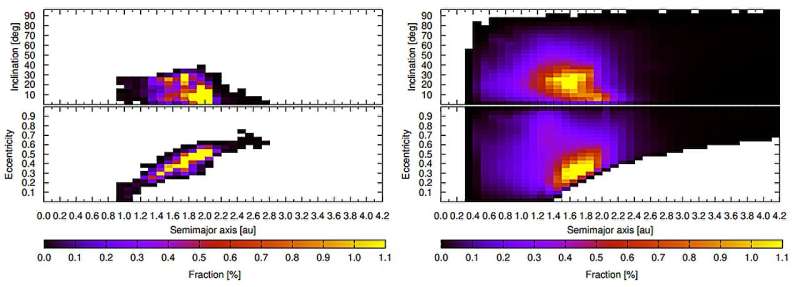December 29, 2023 report
This article has been reviewed according to Science X's editorial process and policies. Editors have highlighted the following attributes while ensuring the content's credibility:
fact-checked
peer-reviewed publication
trusted source
proofread
Model suggests some asteroids that come close to Earth are torn apart by its gravity

A pair of astronomers, one with Luleå University of Technology's Asteroid Engineering Laboratory, in Finland, the other with the Southwest Research Institute, in the U.S., has found via computer simulation, that some large asteroids that come close to Earth can be torn apart by its gravity. Mikael Granvik and Kevin Walsh have posted their paper on the arXiv preprint server—it is scheduled to be published soon in The Astrophysical Journal Letters.
Over the past several years, space scientists have noticed that a lot of asteroids come close to colliding with the Earth but very few actually do so. This has led some in the field to suggest the reason for the difference is the effect Earth's gravity has on asteroids that come near. Due to a stronger pull on the side of an asteroid nearer to Earth, it could be pulled apart, reducing it to a stream of much smaller asteroids. Intrigued by this idea, Granvik and Walsh set out to find a way to test for the possibility.
Their work started a decade ago, as they began studying asteroid data looking for evidence of one that might have been ripped apart by Earth's gravity. Unfortunately, they were not able to find any, likely they thought, due to the resulting stream of smaller asteroids mixing with other small asteroids. That led them to building a model that could be used to calculate trajectories of different sized asteroids that could then be used to estimate the numbers of them at different distances from the Earth.
They then compared what their model showed with real-world data and found that the estimates calculated by their model were far lower. Thinking that the difference might be due to asteroids that had been torn apart, they created a simulation that allowed for tweaking the number of asteroids to include those modified by gravity.
They found that their model simulated the real-world number of small asteroids that have been seen and counted, suggesting that it was capable of simulating the likelihood of larger asteroids being torn apart as they travel near or toward Earth. The gravity of an M-type planet, such as Earth, can remove 50%–90% of the mass of an asteroid during their encounter.
More information: Mikael Granvik et al, Tidal disruption of near-Earth asteroids during close encounters with terrestrial planets, arXiv (2023). DOI: 10.48550/arxiv.2312.08247
Journal information: Astrophysical Journal Letters , arXiv
© 2023 Science X Network





















